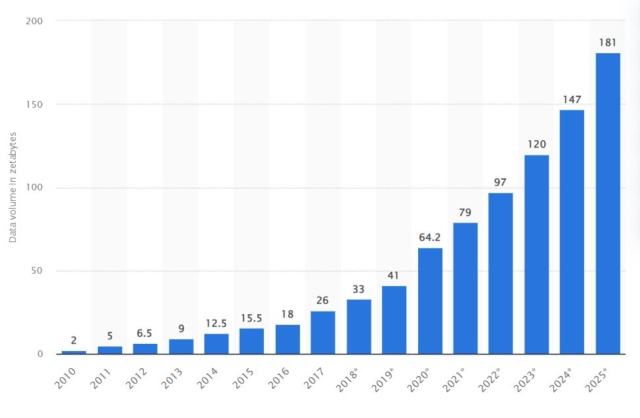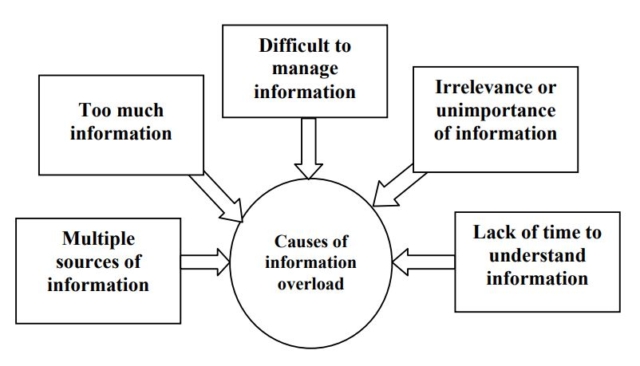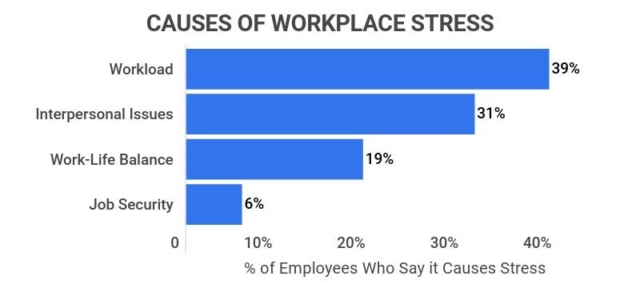Today’s working environment allows employees to handle sophisticated duties and operate high-end digital tools to cope with the tasks and process the data related to different business workflows. The super-dynamic climate at work instigates information overload and prompts other issues that make employees feel cynical and exhausted.
For example, work-life imbalance, obscure job expectations, poor social support, inability to influence decisions, and unfair treatment are common reasons for burnout in the workplace. And information overload here comes as the icing on the cake, arising abruptly and leading to severe health problems that cause a snowball effect.
The Statista Research Department published a study on the amount of data created, captured, copied and consumed globally from 2010-2022, with forecasts up to 2025, and the results were mind-blowing. Global data creation is predicted to increase to 180 zettabytes by 2025.

The volume of data/information created, captured, copied, and consumed worldwide from 2010 to 2020, with forecasts from 2021 to 2025
Information overload is challenging for different working environments. Nevertheless, it critically impacts the digital marketing workplace, with tons of content to process daily. Emails, video conferencing, general phone calls, task-tracking apps, voice mails, chats, screen sharing, and other communications allow for the processing of excessive amounts of data but can be overwhelming for teams and managers.
Even though information overload is a scourge of our time, many companies are still in denial about this problem, disregarding available solutions that could overcome it painlessly and save the business processes and the team. Consequently, this results in problems with employees’ mental, physical, and emotional well-being and directly affects their productivity at work, which also interferes with the businesses’ prosperity and reputation.
SE Ranking’s digital marketing team has prepared for you a practical guide on combating workplace information overload. You will comprehend information overload and discover what causes it in the workplace. Moreover, you will also ascertain how to deal with information and communication overload when unifying communication.
What is Information Overload?
Let’s draw a parallel with devices such as computers and smartphones. When a system receives a large amount of knowledge, it slows down or stops completely. The same thing happens to people in the workplace and everyday life, and it is called information overload. Information overload refers to consuming too much data at once, which then causes mental fatigue, anxiety, and problems with decision-making.
Constant multitasking, the trend of always-available information, and access to diverse information channels like blogs, social media, business communications platforms, instant messaging tools, add-ons and integrations, and other technology perks lead to employee overload and seriously affect businesses and their collaboration opportunities.
Causes of information overload
Information overload is usually caused by an overabundance of knowledge, an irrelevance of retrieved and processed data, and difficulties with information management. Multiple information sources and insufficient time to process the data are also causes of information overload but can be merged with the abovementioned factors.

Image source
The volume of information exchanged in the workplace
The problem with information overload is that it makes people feel overwhelmed. It’s like having too much on your plate. Multiple meetings, calls, messaging with clients and teams, incoming requests via ticket systems, and other steady data flow from different sources elicit confusion and stress. Thus, employees may find it challenging to focus on a task because of many things happening around them.
Irrelevant information Shared with Employees
An excessive amount of information shared at work is one of the many reasons for information overload in business. The quality and relevance of information also affect how employees feel when receiving and processing data, which impacts their performance and well-being.
A lack of alignment between all discussions
Lack of alignment is a giant organisational disease that causes teams, departments, projects, and companies to suffer from a massive decrease in productivity. Problems with internal communications directly affect sales and company revenue and can result in misunderstandings between employees and managers. SE Ranking’s digital marketing team recommends bringing a sense of commitment to the workplace by developing a robust internal communications strategy. It can help to put things in order and align all discussions.
Why are digital marketing teams struggling with information overload?
Information overload is a real issue for digital marketers. It takes effort to stay up-to-date and utilise the most relevant tools when the industry moves so fast. Growth marketing, customer journey map, North Star metric, analytics, social media, customer support quality, and sales dynamics are just a few of the essentials digital marketers should investigate daily. The complete list is much longer. Such a busy atmosphere leads to information and communication overloads that, in turn, cause digital marketers to miss deadlines, forget about urgent tasks, lose sight of critical messages, and more.
Frequency of ad-hoc work
Ad-hoc work is the opposite of managed work. Working on an ad-hoc basis permits tasks to be done as requested, without prior planning and estimates, regardless of the tasks’ size and complexity. Unanticipated reporting, project updates, suddenly adjusted strategic goals, email work, unexpected discussions, and other ad-hoc work is commonplace for digital marketers. Ultimately, this busy working environment with ongoing changes and updates makes the digital marketing workforce experience information overload and burnout.
Communications with different departments
Even though content marketing revenue is constantly growing worldwide, successful digital marketing is about more than just content and advertising. It is a large ecosystem that covers multiple project and product areas and harbours a diversity of business processes. Thus, digital marketing teams are constantly in touch with other company departments like SEOs, backend and frontend web developers, customer support, content managers, sales teams, etc.
Indeed, this ongoing connection requires precise attention to detail and the employment of multiple communication channels. Digital marketers need to take control over everything to build effective brand development strategies and produce high-end content that emphasises the results of the work of the other company teams. This enormous responsibility, along with a never-ending to-do list and daily communications with large groups of colleagues, can result in information and communication overload.
Gathering content from outside resources
Keeping an ear to the ground is crucial for every seasoned digital marketing team. That is why marketers monitor digital trends and track competitors’ websites and content. Nevertheless, gathering loads of content from outside resources takes plenty of time and is a very emotionally draining process. Even though there is a range of digital marketing tools and integrations that help specialists to analyse competitors effectively and simplify data collection, digital marketers still have a lot of work to do. The collected information needs thorough manual assessment and processing for marketing teams to develop a winning strategy.
Active presence on social media
Big brands make big decisions that relate to maintaining a constantly growing online community. The reality is that building a thriving social media presence is a benchmark for every company and organisation. Great content promotes likes, reposts, and new followers. It also boosts user interaction with the brand, making company products and services go viral. Just take a look at one of GoPro’s posts on Instagram to evaluate the brand’s effort on social media.

Image source
Inactive social feeds, outdated designs of social profiles, solely commercial thinking, selling without forming relationships with the audience, and other mistakes will keep the company or brand unknown. That is why staying proactive on social media is a must, even if it requires hard work.
Digital marketers should set smart goals and produce a strategy to satisfy and excite the target audience. Professionals utilise different collaboration tools, manage social media posting schedule, prepare editorial calendars, fine-tune profiles for engagement, improve storytelling, create stunning visuals, and monitor activity, which involves working with excessive amounts of data and causes information overload.
Multitasking
Taking on multiple urgent tasks at the same time, having phone calls and video conversations, replying to tons of messages and emails, developing new strategies, monitoring active campaigns, creating blueprints for upcoming marketing efforts, cooperating with different company teams, and other digital marketing duties are time-consuming and, indeed, nerve-racking.
Due to the enormous list of tasks and responsibilities, digital marketers encounter multitasking which usually generates information and communication overload. In work environments, multitasking interferes with creativity, productivity, decision-making, and employees’ health and well-being.
Information Overload in Unified Communication
Unified communications mean integrating various enterprise communication tools like emails, voicemail, persistent chat, video conferencing, telephone, etc., into a streamlined interface to boost user experience, enhance workforce performance, and cut costs as unified communication systems operate on the cloud.
Although a unified communications environment is a next-generation technology that delivers a comprehensive collection of multimedia and cross-media features and functions, finding the right UC system for your business can take time and effort. Insufficient communication and collaboration tools can lead to information and communication overload.
Firstly, the employment of too many tools creates communication overload and an information-saturated workplace, which directly affects the workforce and customer base. Multiple points of contact create a distraction as users can become overwhelmed with miscellaneous notifications. Moreover, it impacts workforce productivity and can cause issues with servicing clients.
Secondly, an extensive toolkit requires too much time to process all the information and communication channels. According to Zippia’s research, over 80% of employees suffer from work-related stress, and 39% of workers mention their workload as a top stressor in their lives. Employees feel anxious and confused as they are scared of missing the essentials that can affect their work. As a result, the company crew undergoes hardships with accurate data collection and progress tracking.

Image source
Additionally, gaps in the unified communications system can cause problems with prioritisation. These issues may occur due to users having to spend hours sorting things out between different applications with tons of incoming messages instead of using relevant information to complete their current tasks.
How to avoid information overload when you unify communication
Information overload in the workplace can certainly be bewildering and produce plenty of haphazard processes. Nevertheless, patience, time, accurate tools, and a well-thought-out strategy can help you to fight this issue. SE Ranking’s digital marketing team has crafted a selection of handy tips for those who want to overcome information, communication, and employee overload when opting for unified communications.
1. Use communication tools with a wide choice of integrations
Having the right unified collaboration platform means having everything necessary for stable and productive work in one place, and the best part is that you can evade any information silos caused by the inability to synchronise the data in different applications. Unified communication tools with pre-built integrations help automate your workflows and save you from using applications that can’t interoperate with one another.
RingCentral MVP offers superior software for business communications. This unified communications platform is a unique and effective way to empower the entire range of your workplace communications. With RingCentral, you get a leading cloud phone system with exceptional features for seamless phone and video calls, messaging, and analytics. The software is fully compatible with all your devices and offers an essential set of add-ons for better team collaboration. Access the demo library to learn more.
2. Distribute content relevant to employees
The irrelevance of the information you serve to employees directly affects the employee experience, which should be taken into account in every company. Thus, consider rebooting your content strategy by segmenting corporate content. It will rescue workers from having to deal with information that is far from their interests and needs.
3. Create communication channels designated to specific topics or tasks
The surplus of communication channels lacking proper coordination is one of the primary reasons for information overload in the workplace. Corporate emails and newsletters, software for internal messaging and video conferencing, dashboards for project management, and other tools can turn the workflow into a troublesome situation and irritate workers.
To fight information overload caused by failures in enterprise communication, try some centralised options that will help employees find news and updates in one place without having to handle multiple information sources.
4. Manage personal notifications
Workplace information overload also happens because constant notifications distract employees and slow down their workflow. Choose unified communication tools with built-in settings for greater control over the number and type of notifications received during the day. Your workforce will be elated at the opportunity to complete tasks faster and receive messages directly associated with their department and functions.
5. Use AI digital personal assistants
Technology has progressed far beyond the limit of delivering outstanding AI-powered solutions for streamlining business communications and enhancing their quality. Thus, you can take advantage of AI digital personal assistants, also called AI engines, to analyse messaging and ensure the most relevant communications are seen first.
AI engines refer to self-learning algorithms that ignore or categorise different messages with the help of filtering and routing features. These tools significantly improve the user experience and help combat information overload in the workplace.
6. Choose the most appropriate means of communication
Various company tasks need suitable approaches to foster successful discussions and the achievement of goals. Therefore, examine your current communications and determine the best communication methods for particular tasks. For example, emails have to become phone or video calls because of a high bandwidth that impacts communication efficiency. Consider the type and priority of tasks to employ appropriate tools and avoid communication overload.
7. Gather feedback regarding unified communication
Your employees’ voice matters. Therefore, feel free to ask your crew for feedback to evaluate the power of your strategies. Different questionnaires can help you to understand how your employees prefer to receive essential information and what notifications they would like to omit. Regular surveys are also a great tool for making sure your talents feel comfortable at work and are satisfied with their daily workflows.
You can make your surveys anonymous so that your employees are more likely to share authentic feedback. The main goal here is to make the necessary adjustments after hearing back from your employees.
8. Track your progress
Proper progress measurements act as a valuable guide toward reaching your goals. Therefore, measuring employee engagement, readership, and the impact of communication on the entire organisation is crucial for every involved business owner. Track the effectiveness of the changes and innovations implemented in your communications on an ongoing basis and pay close attention to the employee experience.
The takeaway
Information overload refers to pain points that make companies lose qualified specialists. Problems with excessive amounts of information and data in the workplace lead to employee burnout and can cause severe problems with health and well-being. Therefore, your primary mission is to eliminate information and communication overload early on to keep your workforce productive and pleased with their work.
Technology offers a solution to workplace information overload. An up-to-date, unified communications platform with high-end collaboration tools will help to ease the information flow by providing your employees with a full-featured place to gather data and fulfil their tasks. Make an effort to empower the selected UC system of your choice to combat information overload.
Ensure your employees receive content that is relevant to their duties, don’t let the multitasking go too far, check if your workforce is satisfied with the software that has been implemented, and value your employees’ feelings at work. By doing so, any problem with information overload will vanish into the blue.
Originally published Jan 20, 2023
